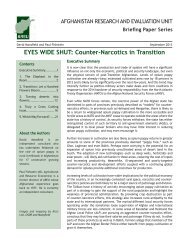Local Governance in Afghanistan: A View from the Ground
Local Governance in Afghanistan: A View from the Ground
Local Governance in Afghanistan: A View from the Ground
- No tags were found...
Create successful ePaper yourself
Turn your PDF publications into a flip-book with our unique Google optimized e-Paper software.
<strong>Afghanistan</strong> Research and Evaluation Unit<br />
2011<br />
<strong>the</strong> amount of off-budget allocations. However, with security deteriorat<strong>in</strong>g <strong>in</strong> large parts of <strong>the</strong><br />
country and public discontent grow<strong>in</strong>g, it would be <strong>in</strong> <strong>the</strong> <strong>in</strong>terests of both donors and <strong>the</strong> government<br />
to come up with a clearer strategy on how allocations should be made to various sectors and to<br />
development programmes. At <strong>the</strong> same time, a sense of realism needs to prevail over what can be<br />
accomplished with<strong>in</strong> given time scales.<br />
Policy Issues: The Jo<strong>in</strong>t Coord<strong>in</strong>ation and Monitor<strong>in</strong>g Board (JCMB) should <strong>in</strong>tensify its efforts to<br />
<strong>in</strong>crease donor and government coord<strong>in</strong>ation <strong>in</strong> <strong>the</strong> field of local government, plac<strong>in</strong>g an emphasis<br />
on multi-year fund<strong>in</strong>g. For efficient disbursement of funds, sector-specific partnerships could be<br />
established at <strong>the</strong> prov<strong>in</strong>cial level between l<strong>in</strong>e departments and INGOs/NGOs. Greater emphasis<br />
should be placed on monitor<strong>in</strong>g and evaluation—not just of outputs and processes, but also of outcomes<br />
and impacts—and <strong>the</strong> parameters for do<strong>in</strong>g so should be decided on jo<strong>in</strong>tly by all stakeholders<br />
<strong>in</strong>volved. To avoid fur<strong>the</strong>r aid dependency, control and management of programmes should lie with<br />
government <strong>in</strong>stitutions. More responsibilities should be devolved to local government to make<br />
development programmes more effective. Development and security dimensions of engagement<br />
should be kept separate and aid should not be militarised. It will also be critical to consider how best<br />
to manage and coord<strong>in</strong>ate <strong>the</strong> decl<strong>in</strong>e and possible curtailment of fund<strong>in</strong>g for many development<br />
<strong>in</strong>itiatives that will come with withdrawal of coalition forces.<br />
7.10 Service delivery<br />
Delivery of goods and essential services was probably <strong>the</strong> biggest challenge for <strong>the</strong> newly-formed Afghan<br />
government after 2001. Adm<strong>in</strong>istrative structures had been weakened by years of civil war and Taliban<br />
rule. The Taliban left beh<strong>in</strong>d systems that were grossly <strong>in</strong>adequate to meet <strong>the</strong> needs of citizens,<br />
particularly those <strong>in</strong> more isolated communities, who largely had to depend on <strong>the</strong>mselves. The high<br />
numbers of refugees return<strong>in</strong>g <strong>from</strong> Iran and Pakistan <strong>in</strong> <strong>the</strong> ensu<strong>in</strong>g years created additional pressures.<br />
Despite this, a great deal has been achieved s<strong>in</strong>ce <strong>the</strong>n. The government has shown commitment to<br />
adm<strong>in</strong>istrative reforms. Prov<strong>in</strong>cial and district l<strong>in</strong>e departments have been staffed, and <strong>the</strong> MoPH<br />
has made rapid improvements <strong>in</strong> <strong>the</strong> health sector via public-private partnerships with NGOs. Most<br />
significantly, <strong>the</strong> NSP has brought development to places previously untouched by <strong>the</strong> state.<br />
However, service delivery rema<strong>in</strong>s a persistent issue for governments, particularly s<strong>in</strong>ce <strong>the</strong> Taliban<br />
and o<strong>the</strong>r armed groups now have effective control over considerable areas of <strong>the</strong> country. This<br />
is significant as <strong>the</strong> legitimacy of <strong>the</strong> Afghan state h<strong>in</strong>ges on, among o<strong>the</strong>r th<strong>in</strong>gs, its ability to<br />
effectively deliver services to its population. In conflict-affected districts, <strong>the</strong> research found that<br />
movement of government employees was often limited to <strong>the</strong> immediate vic<strong>in</strong>ity of <strong>the</strong>ir offices.<br />
Travell<strong>in</strong>g to prov<strong>in</strong>cial centres was dangerous and <strong>the</strong> transportation of goods posed a major risk to<br />
<strong>the</strong> government and public alike. There is <strong>the</strong>refore a need to devise mechanisms that allow service<br />
delivery to take place <strong>in</strong> <strong>in</strong>secure areas. While <strong>the</strong> suggestion may be controversial <strong>in</strong> some quarters,<br />
this could conceivably be achieved through a greater level of negotiation with <strong>the</strong> armed groups that<br />
have de facto control <strong>in</strong> some of <strong>the</strong>se areas.<br />
The difficulties experienced by prov<strong>in</strong>cial governments <strong>in</strong> execut<strong>in</strong>g development budgets present<br />
a major challenge for service delivery. The MoF reports that only 37 percent of <strong>the</strong> development<br />
budget was disbursed <strong>in</strong> 2010-11, compared to 92 percent of <strong>the</strong> operational budget. 149 A primary<br />
reason for <strong>the</strong> low execution rate of development budgets is <strong>the</strong> lack of coord<strong>in</strong>ation between<br />
donors and <strong>the</strong> government, as highlighted above. However, <strong>the</strong> difference between <strong>the</strong> execution<br />
rates of development and operational budgets also po<strong>in</strong>ts to <strong>the</strong> <strong>in</strong>ability of l<strong>in</strong>e m<strong>in</strong>istries to deliver<br />
services efficiently to local populations through current centralised mechanisms. The existence of<br />
well-staffed l<strong>in</strong>e departments that are unable to respond to service delivery needs suggests that too<br />
much of current plann<strong>in</strong>g and budgetary responsibility is conf<strong>in</strong>ed to central m<strong>in</strong>istries. While local<br />
government officials can identify problems and communicate <strong>the</strong>m to authorities <strong>in</strong> prov<strong>in</strong>cial and<br />
central offices, <strong>the</strong>y have little control over resources. Fur<strong>the</strong>rmore, weak <strong>in</strong>formation flows between<br />
different tiers of m<strong>in</strong>istries have resulted <strong>in</strong> significant misappropriation and thus fur<strong>the</strong>rs <strong>the</strong><br />
149 Steve A. Zyck, “‘Use It or Lose It’: Budget Execution <strong>in</strong> <strong>Afghanistan</strong>” (Norfolk, Virg<strong>in</strong>ia: Civic-Military Fusion Centre, April 2011).<br />
<strong>Local</strong> <strong>Governance</strong> <strong>in</strong> <strong>Afghanistan</strong>: A <strong>View</strong> <strong>from</strong> <strong>the</strong> <strong>Ground</strong><br />
65

















